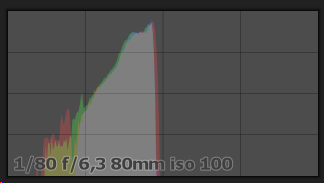Here they go:
0EV
IMG_4236.CR2 (10.4 MB)
+1/3 EV
IMG_4237.CR2 (10.4 MB)
+2/3 EV
IMG_4238.CR2 (10.4 MB)
+1 EV
IMG_4239.CR2 (10.5 MB)
Here they go:
0EV
IMG_4236.CR2 (10.4 MB)
+1/3 EV
IMG_4237.CR2 (10.4 MB)
+2/3 EV
IMG_4238.CR2 (10.4 MB)
+1 EV
IMG_4239.CR2 (10.5 MB)
Out grocery shopping with wife, will look when we get home…
![]() Thanks!
Thanks!
Hi again!
Which metering mode do you use:
evaluative, center-weighted, partial, spot?
Have fun!
Claes in Lund, Sweden
I used evaluative for the grey card shots.
EDIT: Changed to spot and took a grey card shot again and the histogram is a bit more underexposed:

I’m sorry about this, but the previous histogram images are considering a base curve applied to the image.
Turning it off, the 0 EV histogram is like this:

and the +1 EV

Could you redo your raw files with spot metering (and the typical grey card shot considerations)?
Also, +2/3 EV and +1 EV have both “1/15” marked on the histogram… EXIF error?
Would the 0 EV be enough?
_MG_4250.CR2 (10.4 MB)
What would they be?
Don’t have a clue. On Digikam it shows the same way.
@gadolf, the camera metering works under the assumption that illumination of pixels in a typical normal photograph averages out to middle grey.
Therefore, if you take a photo of a grey card with camera suggested exposure, its histogram will be bunched in the middle. So your camera’s metering is working as expected.
If you take a photo of a white card, the output should be a grey card and the histogram will be the same!
… but it doesn’t, right?
Take a look at the last histogram I showed (with base curve turned off). I shot that one without any exposure compensation (0 EV), with the camera suggested exposure. Shouldn’t the histogram be in the middle?
Every camera have certain tendencies. The manufacturer likes to give some signature so to speak. Your camera seem to be underexposing a stop. This does not mean malfunction. Once you know this, and if you don’t like it, then you can correct it manually.
Also, I think that you should apply the base curve to the photo for the histogram evaluation. Because the expected output is a jpeg for manufacturers. Thus the exposure is also computed with basic adjustments in mind.
If you say so, then, I’ll accept that.
In fact, my previous experience with digital cameras is almost non-existent. Before this one, there’s my powershot, and before that, a 4MP Nikon point and shoot.
The strange thing is that if I compensate, say, 2/3 stops, depending on the subject, the resulting image gets really overexposed. It’s like it’s not a constant deviation.
18% grey subject.
I really do not want to make things more complicated, but are you sure your grey subject is reflecting 18%???
@agriggio’s link covers that. Fortunately, you don’t need RawDigger to examine your raw files.
I wouldn’t do that if I were examining the raw file. And as I and then others have indicated, I wouldn’t process with the base curve most of the time, esp. if you are using filmic.
Other remarks
1. It is entirely possible that your metering is broken. It is not unusual but don’t assume it is so right away.
2. Metering is tied to focusing (and possibly WB). You can separate the two for composing if you prefer a feature like back button focus, etc.
3. Metering is tied to the histogram (or the live view), which is unfortunately the case for all cameras tied to the JPG preview, not the raw file.
4. Due to point 3, your metering would be off say about 1-1.5 EV if your goal is to do ETTR. We call that headroom. For less technical photographers, the headroom actually protects them from overexposure; it is a good thing unless you know what you are doing.
5. Use Manual mode. That way, you get full control over your settings. The are many settings to turn off if you want your live preview to reflect the raw output as much as possible.
6. I had other things to say but I forget… ![]()
The problem is evaluative metering, you can’t really count on it as a base for personalized exposure. If you need to be precise measuring the light then you’ll have to resort to center-weighted or spot metering.
Not sure what you mean.
It is probably the cheapest card in the market. It’s only a cheap cardboard. But it’s sold as 18% grey, for photography.
Not sure why you’ve pointed to a 12% grey, although I’m aware of the 12 x 18% grey dispute (although I don’t understand it ![]() ).
).
If you are really pedantic, not all materials are equal and useful in all situations. ![]()
Thanks @afre for your comments.
Fyi, I turned off every possible setting that might be pushing the image from the neutral stance, although I’m not looking at the camera’s histogram. (But it’s good information knowing that the in camera histogram comes from the jpg)
As for point #1, that’s the one I’m trying to discard, although I agree with @shreedhar that even if the metering presents a bias I can compensate for that.
That’s what I thought it could mean, and probably it isn’t the best one. But even so, would it cause more than one stop shift, like it seems to be the case?